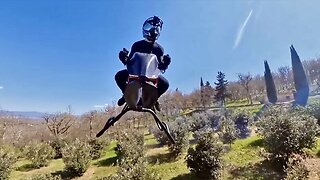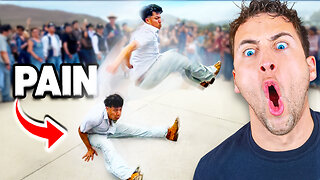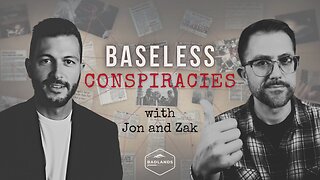Premium Only Content

Best Kind of War Story - True Tale of Aerial Chivalry - Enemy Pilot Refuses to Shoot Down Plane
The Charlie Brown and Franz Stigler incident occurred on 20 December 1943, when, after a successful bomb run on Bremen, 2nd Lt Charles "Charlie" Brown's B-17 Flying Fortress (named "Ye Olde Pub") was severely damaged by German fighters. Luftwaffe pilot Franz Stigler had the opportunity to shoot down the crippled bomber, but did not. After an extensive search by Brown, the two pilots met each other 40 years later and developed a friendship that lasted until Stigler's death in March 2008.
2nd Lt Charles L. "Charlie" Brown ("a farm boy from Weston, West Virginia", in his own words) was a B-17F pilot with the 379th Bombardment Group of the United States Army Air Forces' (USAAF) 8th Air Force, stationed at RAF Kimbolton in England. Franz Stigler, a former airline pilot from Bavaria, was a veteran Luftwaffe fighter pilot attached to Jagdgeschwader 27 (fighter band 27); at the time, he had 27 victory tallies to his name and would be eligible for the coveted Knight's Cross with one more downed enemy bomber (the required number of victories was 30). (In Nazi Germany, the shooting down of a bomber aircraft was worth 3 points compared to a fighter's one.)
Brown's B-17 began its 10-minute bomb run at 27,300 ft (8,300 m) with an outside air temperature of −60 °C (−76 °F). Before the bomber released its bomb load, accurate flak shattered the Plexiglas nose, knocked out the number two engine and further damaged the number four engine, which was already in questionable condition and had to be throttled back to prevent overspeeding. The damage slowed the bomber and Brown was unable to remain with his formation and fell back as a straggler – a position from which he came under sustained enemy attacks.
Brown's straggling B-17 was now attacked by over a dozen enemy fighters (a mixture of Messerschmitt Bf 109s and Focke-Wulf Fw 190s) of JG 11 for over 10 minutes. Further damage was sustained, including damage to the number three engine, which would produce only half power (meaning the aircraft had at best 40% of its total rated power available). The bomber's internal oxygen, hydraulic and electrical systems were also damaged, and the bomber lost half of its rudder and its port (left side) elevator, as well as its nose cone. Many of the gunners' weapons then jammed, probably as a result of loss of the onboard systems leading to frozen mechanisms (the ground crew did not oil the guns correctly), leaving the bomber with only two dorsal turret guns and one of three forward-firing nose guns (from eleven available) for defense. Most of the crew were wounded: the tail gunner, Eckenrode, had been decapitated by a direct hit from a cannon shell, while Yelesanko was critically wounded in the leg by shrapnel, Blackford's feet were frozen due to shorted-out heating wires in his uniform, Pechout had been hit in the eye by a cannon shell, and Brown was wounded in his right shoulder. The morphine syrettes onboard froze, complicating first aid efforts by the crew, while the radio was destroyed and the bomber's exterior heavily damaged. Miraculously, all but Eckenrode survived.
Franz Stigler
Brown's damaged bomber was spotted by Germans on the ground, including Franz Stigler (then an ace with 29 victories), who was refueling and rearming at an airfield. He soon took off in his Messerschmitt Bf 109 G-6 (which had a .50 caliber Browning machine gun bullet embedded in the radiator, which risked the engine overheating) and quickly caught up with Brown's plane. Through the damaged bomber's airframe Stigler was able to see the injured and incapacitated crew. To the American pilot's surprise, Stigler did not open fire on the crippled bomber. Stigler recalled the words of one of his commanding officers from Jagdgeschwader 27, Gustav Rödel, during his time fighting in North Africa, “If I ever see or hear of you shooting at a man in a parachute, I will shoot you myself." Stigler later commented, "To me, it was just like they were in a parachute. I saw them and I couldn't shoot them down."
Brown managed to fly the 250 mi (400 km) across the North Sea and land his plane at RAF Seething, home of the 448th Bomb Group and at the postflight debriefing informed his officers about how a German fighter pilot had let him go. He was told not to repeat this to the rest of the unit so as not to build any positive sentiment about enemy pilots. Brown commented, "Someone decided you can't be human and be flying in a German cockpit." Stigler said nothing of the incident to his commanding officers, knowing that a German pilot who spared the enemy while in combat risked execution. Brown went on to complete a combat tour. Franz Stigler later served as a Messerschmitt Me 262 jet-fighter pilot in Jagdverband 44 until the end of the war.
Music: SOS by Dhruva Aliman
Amazon- https://amzn.to/3eAjEgC
https://music.apple.com/us/artist/dhruva-aliman/363563637
https://dhruvaaliman.bandcamp.com/album/what-must-be
Spotify - https://open.spotify.com/artist/5XiFCr9iBKE6Cupltgnlet
https://www.dhruvaaliman.com/
-
 3:39
3:39
Knowledge Land
2 months agoYour Personal Flying Scooter - Airbike Is Here - Volonaut
29 -
 10:47
10:47
Nikko Ortiz
13 hours ago15 Seconds Of Fame Gone WRONG...
2.29K2 -
 14:47
14:47
GritsGG
1 day agoRumble Tournament Dubular! Rebirth Island Custom Tournament!
60.7K4 -
 1:36:05
1:36:05
Side Scrollers Podcast
15 hours agoStreamer ATTACKS Men Then Cries Victim + Pronoun Rant Anniversary + More | Side Scrollers
63.9K2 -
 LIVE
LIVE
Lofi Girl
2 years agoSynthwave Radio 🌌 - beats to chill/game to
774 watching -
 42:55
42:55
Stephen Gardner
1 day ago🔥Trump’s SURPRISE Move STUNS Everyone - Democrats PANIC!
56.1K110 -
 1:37:19
1:37:19
Badlands Media
13 hours agoBaseless Conspiracies Ep. 148: The Delphi Murders – Secrets, Setups, and Cover-Ups
30.4K14 -
 5:59:05
5:59:05
SpartakusLIVE
7 hours ago#1 MACHINE Never Stops The GRIND || LAST Stream UNTIL Friday
132K1 -
 28:36
28:36
Afshin Rattansi's Going Underground
1 day agoDoug Bandow: ENORMOUS DAMAGE Done to US’ Reputation Over Gaza, Trump ‘Easily Manipulated’ by Israel
19.7K29 -
 2:45:13
2:45:13
Barry Cunningham
13 hours agoCBS CAUGHT AGAIN! CHICAGO A MESS! LISA COOK IS COOKED AND MORE LABOR DAY NEWS!
96.7K48